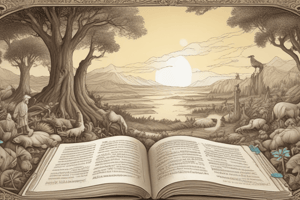Podcast
Questions and Answers
Why is organization particularly important in informational texts?
Why is organization particularly important in informational texts?
- It helps the reader follow complex information and understand the author's purpose. (correct)
- It allows the author to express personal opinions more effectively.
- It provides a framework for creative writing and imaginative storytelling.
- It enables the reader to engage with fictional narratives more easily.
How does a table of contents primarily aid readers in understanding an informational text?
How does a table of contents primarily aid readers in understanding an informational text?
- By outlining the main topics and the order in which they appear, giving a structural overview. (correct)
- By providing detailed definitions of key terms used throughout the text.
- By offering a comprehensive summary of the main arguments presented in each section.
- By listing all the subjects alphabetically with corresponding page numbers.
In what way does an index enhance the usability of an informational text?
In what way does an index enhance the usability of an informational text?
- By enabling readers to quickly locate specific topics without reading the entire text. (correct)
- By summarizing the main points of each chapter for quick review.
- By providing a note from the author explaining the motivation and goals behind the text.
- By offering a list of terms with definitions and pronunciation guides.
What is the primary function of headings and subheadings in an informational text?
What is the primary function of headings and subheadings in an informational text?
Which supplemental feature would be most helpful for quickly understanding the meaning of specialized vocabulary used in an informational text?
Which supplemental feature would be most helpful for quickly understanding the meaning of specialized vocabulary used in an informational text?
An author is writing an informational text about the impact of deforestation on local ecosystems. Which of the following graphic aids would be MOST effective in illustrating the changes in forest cover over time?
An author is writing an informational text about the impact of deforestation on local ecosystems. Which of the following graphic aids would be MOST effective in illustrating the changes in forest cover over time?
In an informational text, an author uses bold print, colored words, and italics. What is the MOST likely reason for the author to use these?
In an informational text, an author uses bold print, colored words, and italics. What is the MOST likely reason for the author to use these?
An author is writing an article describing a complex chemical process. Which of the following visual aids would BEST help readers understand the process?
An author is writing an article describing a complex chemical process. Which of the following visual aids would BEST help readers understand the process?
An author includes a series of bullet points in an informational text. What is the PRIMARY purpose of this formatting choice?
An author includes a series of bullet points in an informational text. What is the PRIMARY purpose of this formatting choice?
An author is writing a report on global population changes. Which graphic would BEST illustrate the population growth trends of different countries over the past 50 years?
An author is writing a report on global population changes. Which graphic would BEST illustrate the population growth trends of different countries over the past 50 years?
Flashcards
Informational Texts
Informational Texts
Nonfiction, factual writings aimed at informing the audience.
Print Features
Print Features
Guides that help navigate and understand the structure of a paper.
Table of Contents
Table of Contents
A list of the parts of a paper, usually found at the beginning.
Preface
Preface
Signup and view all the flashcards
Index
Index
Signup and view all the flashcards
Author's Structural Signals
Author's Structural Signals
Signup and view all the flashcards
Informational Graphics
Informational Graphics
Signup and view all the flashcards
Graphs
Graphs
Signup and view all the flashcards
Tables
Tables
Signup and view all the flashcards
Maps
Maps
Signup and view all the flashcards
Study Notes
- Organization is important in writing, especially for informational texts.
- Informational texts are nonfiction, factual writings that aim to inform or build upon existing knowledge.
- Authors use supplemental features to organize informational texts.
Print Features
- Print features guide the reader through the paper.
- A table of contents is a list of the parts of a paper, organizing the main ideas and showing the order of sections.
- A preface is a note from the author stating the purpose of the content.
- An index is an alphabetical list of subjects in the essay with page numbers.
- A glossary is a list of terms with definitions and pronunciations.
Organizational Aids
- Organizational aids help readers find important information.
- Headings identify the main topics, while subheadings separate them into main details.
- Font changes, like bold print, colored words, or italics, emphasize key words.
- Lists present a lot of information concisely, often using bullets, labels, or sidebars.
- Sidebars provide additional information in the margins.
Graphics and Illustrations
- Graphics and illustrations expand meaning through visuals or summarize key ideas.
- Illustrations include photographs or drawings to show what something looks like.
- Graphs show relationships between topics, often for comparisons or statistics.
- Tables summarize or compare information, typically statistics.
- Maps show where something took place, highlighting areas discussed.
- Diagrams simplify complex information.
- Graphics and illustrations condense important information make comparisons without being too wordy.
Studying That Suits You
Use AI to generate personalized quizzes and flashcards to suit your learning preferences.




